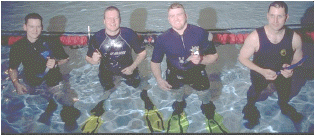
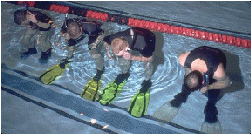
An Exercise For Reducing No-Mask-Swimming Anxiety
by
Larry "Harris" Taylor, Ph.D.
Underwater Photography by Mike Spears
This
material is copyrighted and the authors retain all rights.
This article is made available as a service to the diving community by the
authors and may be distributed for any non-commercial or Not-For-Profit use.
All rights reserved.
This article is based on material presented in the author's basic class
Go To: Home About "Harris" Articles Slides War Stories Editorials Links Fini
The people who treat diver injuries tell me that incidents and injuries related to "escape to the surface" behavior are increasing. Far too often this injury is associated with rapid flight to the surface initiated as a consequence of a flooded mask. I believe this "escape-to-the-surface behavior" is a consequence of NOT allowing people with land-dwelling survival instincts the in-water training time necessary to adapt (see Primitive Brain ) to their new-found underwater habitat. The exercise described below is the "best" (in terms of rapid development of water-on-the-face comfort) that I have ever seen and, as such, it is part of my teaching "bag of tricks."
When I was a child I experienced multiple near-drowning events. So, as an adolescent and young adult I had a fear, no! make that a terror of being under the surface of the water. Even though I was fascinated by the undersea realms of Jules Verne and other science fiction writers, as well as the scientific and historical accounts of underwater explorations, my nightmares of being held under the silver-colored surface of the water kept me primarily a land-dweller. A lab colleague ( Remember My Friend Dan ) received his instructor's card in 1977 and offered everyone in our lab a "free" course. When I expressed my apprehensions about my taking a scuba class, Dan convinced me that the experience of basic diver training would be good immersion therapy (pun intended) for reducing the horror I associated with my being under the water.
He suggested that I try the exercise described below as a mechanism to cope with my in-water discomfort. Given the enormity of my terror, it took me tens of hours with my face in the water to become comfortable. But, the exercise worked for me. The rest, as they say, is history.
I now recommend this exercise to all my students (as "homework") prior to their first attempts at mask clearing. It is, for me, as an instructor, the procedure of choice whenever I sense a student expressing the natural land-dweller's discomfort at initial mask clearing attempts. I have never seen this exercise fail to build an increased comfort level in no-mask drills. The difference in a student's mask clearing skill, pre- and post mastery of the simple task described below, is often quite remarkable!
The exercise is simple: Simply place your face in the water without a mask and breathe through a snorkel. This can be done in a pool class with a group (see below) or individually, at home, by placing the head in-water either in a sink or bath tub. It is NOT important to me or anyone else how long it takes to become comfortable. (A scientist would say this is a "path independent process."). The only thing that matters is that, at some point in time, the drill can be done without discomfort. For most folks, this is less than an hour.
In a classroom mode, the class simply bends at the waist and breathes through their snorkel.


Underwater (Left, from below and Right, from the side), it looks like this:
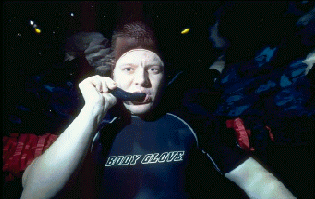
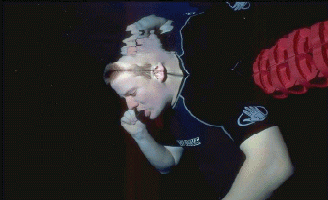

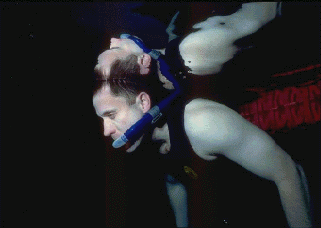
Conclusion
I have personally experienced coping with someone who had never removed their mask in training ( Battle Rorale ). It is inevitable that all who dive will at some time experience a flooded mask. Being comfortable with water on the face should be an inconvenience and not a life-threat. So, I strongly believe that in-water comfort with water on the face is an absolute requirement in basic training.
This simple exercise is a superb means of overcoming the natural discomfort that is felt by novice scuba diving students when first learning to remove their mask while underwater. It is particularly useful in assisting those with mask clearing (because of the natural human land-dweller's discomfort generated by water-on-the face in a position that places the nose in a non-breathable environment) difficulties. Once this exercise is mastered (comfort level achieved ... water-on-the-face anxiety reduced), then mask clearing and other no-mask skills are much easier to learn because the student's focus can now be directed at the more complex task being taught.
Acknowledgement
Thanks to:
Divers (Group above, Left to Right): George Durant, Brian Nowak, Jeremy Epple, and Darin Cates (U of MI Scuba Teaching Assistants)
Go To: Home About "Harris" Articles Slides War Stories Editorials Links Fini
Larry "Harris" Taylor, Ph.D. is a biochemist and Diving Safety Coordinator at the University of Michigan. He has authored more than 200 scuba related articles. His personal dive library (See Alert Diver, Mar/Apr, 1997, p. 54) is considered one of the best recreational sources of information In North America.
All rights reserved.
Use of these articles for personal or organizational profit is specifically denied.
These articles may be used for not-for-profit diving education